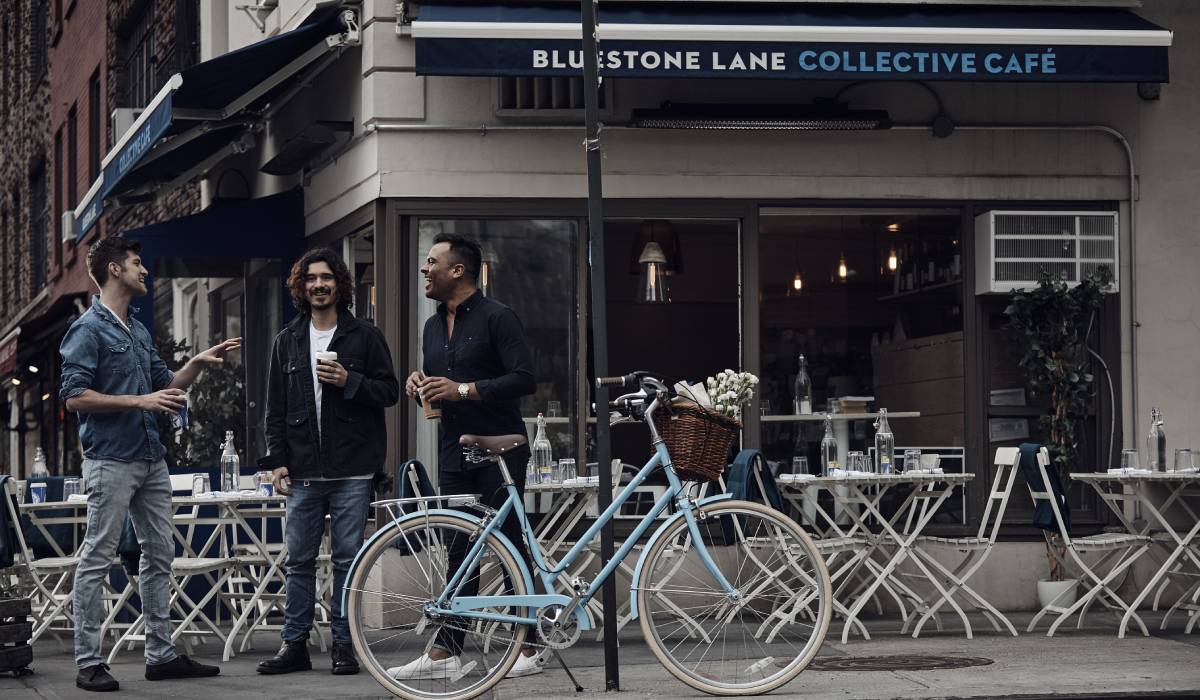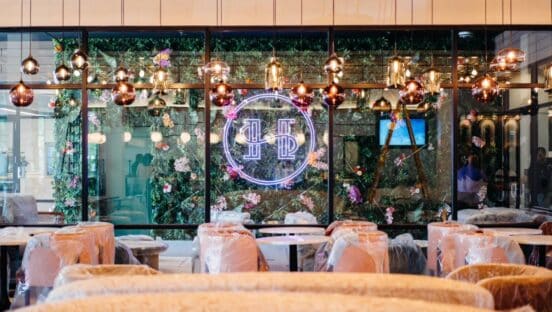Bluestone Lane, which serves Australian-based coffee, wants to achieve “boutique in scale,” a philosophy rooted in the country’s history with caffeine.
As CEO and founder Nick Stone explains, the U.S. moved from a drip coffee culture to espresso-based in the late 1980s and early 1990s, a shift that was commercialized by Starbucks and others. Before, it was only found in niche areas and pockets of society linked to migrants from Western Europe.
As a British colony, Australia was heavily into tea culture, but during World War II there was a mass migration from Western Europe markets like Italy, Greece, and Malta. In turn, the country switched from tea to espresso in the 1940s, and in the following years that’s grown into a vibrant and personalized premium coffee market.
The market is so premium that major brands like Starbucks and Dunkin’ have failed to successfully expand in Australia. It’s the arena of independents, Stone says.
“When you talk about two different coffee cultures, you have the U.S., which is the land of chains dominated by Starbucks and Dunkin’, versus Australia where you have no chains that dominate,” he says. “It’s all about the independent operator. And what does that mean? It means that the standards of service, the standard of product experience, is so high because you have the owner/operator, the proprietor in there, spending so much time focusing on the engagement with their locals—not customers—and making them feel so special.”
When Stone first arrived in New York by the way of Melbourne in 2010, he missed the small independent operator that knew his order when he walked in. He says U.S. coffee chains are led by products and built for convenience and scale, while Australian coffeehouses are inspired by service and community.
That’s where Bluestone’s “boutique in scale” mindset comes into play. The 50-unit coffee brand wants to open hundreds of locations, but ensure it still feels like a collection of specialized stores with individuality in terms of look, guest experience, and composition of employees. Bluestone encourages reciprocal relationships, not ones that appear homogenous and transactional.
Founders: Nicholas Stone
Headquarters: New York, NY
Year started: 2013
Annual sales: $50,000,000
Total units: 50
Franchised units: 0
The company expects to finish 2021 with about 60 locations and anticipates a minimum of 20 openings in 2022. But there’s potential to far exceed that based on the growing pipeline. At that level, Stone says, Bluestone will be the largest boutique retail, coffee, and café concept in the U.S. and the biggest Australian hospitality export.
“What you do find in the major metropolitan cities, the tier-one cities of the world, whether it’s London or Hong Kong or Singapore or Paris or New York, what you do find in all of those markets is a number of Australian or New Zealand premium coffee shops or cafés,” Stone says. “And for us we see ourselves as being the face of that movement, the largest player where you can go into these major cities in the U.S. and internationally and know that there’s going to be a Bluestone Lane there and you’ll have the personalization as it relates to the type of atmosphere in the store and the team, but you’ll have uniformity with the things that matter, like the quality of the beverage, the quality of our food, the consistency, and the speed.”
Bluestone’s growth strategy was unquestionably influenced by COVID, which caused the chain to close 20 percent of its fleet and temporarily shutter others. At one point, the brand was down to 14 locations. The chain overcame the blow because of its diversification in different markets. On one hand, Bluestone has smaller-sized coffee shops, which are focused on speed and based in densely populated areas, like the bottom of office towers. Then there are bigger suburban-based cafés that serve as community beacons and offer a larger menu and table service.
Bluestone’s coffee shops were severely impacted by individuals working from home while the more residential cafés thrived. The difference in performance forced Bluestone to seriously consider how it manages real estate, and the goal now is to push into suburban locales. Stone, which identifies Bluestone as the largest premium coffee brand in New York City, says the chain is looking to expand in commuter towns around New York, New Jersey, and Connecticut. The company will also explore pushing further into Southern California and entering the commuter rings of Dallas, Houston, and Austin.
The expansion of cafés is phase one. The next step is opening smaller coffee shops in these same areas, but with a drive-thru.
“We’re not pushing too deep, but where it still has connectivity to the cities and the central business district where we already have a presence,” Stone says. “It has been a big shift from smaller footprint coffee shops in captive areas, which was two-thirds of our portfolio, to now cafés with a larger format and offer the convenience of curbside pickup for vehicles.”
While most emerging brands grow regionally at first, Bluestone already has a heavy presence on both the West Coast and East Coast in California and New York. The coffee chain made this decision because it recognized that 90 percent of its customer base are millennials who are moving into specific cities on both ends of the country. With these trends in sight, the concept saw the best opportunity to extend its reach.
Stone acknowledges it’s a risky strategy to spread a brand so early into existence, especially without abundant capital. But the CEO had confidence in Bluestone’s products, tech stack, and management team. So far the strategy has paid dividends.
“We got the diversification that we needed with so many of our Northeast markets so badly hit from COVID,” Stone says. “We have some diversification in Los Angeles that wasn’t as impacted as severely because the business district is not as large there and we’re not in it. We’re in more residential urban areas. Coffee is a wonderful anchor product because it’s stood the test of time. It has a massive addressable market and it has annuity like property. So we knew it was risky, but we thought if we’re able to achieve it, we would grow our brand equity and awareness transformatively. And I’m very, very proud that in every market that we’ve entered, we’ve been received so well, every store has more than four stars on Yelp and the advocacy has been pretty incredible.”
All of Bluestone’s stores are company-run, yet the brand is interested in licensing with the right strategic partners. In the U.S, Bluestone Lane has licensing agreements with JFK International Airport, LaGuardia, Boston Logan International, and 20th Century Studios in Los Angeles. Licensing is more of a priority in international markets where Bluestone can rely on the expertise and resources of local operators.
Franchising has been discussed, but nothing that would come to fruition in the short-term.
“I think we have to have a lot of confidence in the master franchisee and what they’ve been able to achieve in a certain market,” Stone says. “I think it would be entering markets where we don’t feel that we want to be company-owned because we don’t have connection, we don’t have contacts, and we just feel that we’re probably spread too thin at this stage in our life cycle. So there’s a lot of markets in the U.S. where we constantly receive offers to consider franchising. Every week I get a couple of emails asking me whether I would consider it, and I would with the right master franchisee. A group that is experienced, has the capital, the ambition, and the growth agenda that can be great stewards of our brand.”
As Bluestone approaches unit growth, it continues to run digital infrastructure built for the future. The brand recently launched a proprietary mobile app that allows customers to order dine-in, native delivery, and takeout. Through the app, Bluestone has the ability to convey personalized communications about special offers and allow customers to earn and redeem awards through the loyalty program, which is more akin to an experiential hotel or airline program as opposed to discounting.
Roughly 90 percent of Bluestone’s orders are digital.
“It is a transformative piece of technology,” Stone says. “It provides that convenience and support to improve our local’s experience. It gives them ability to order ahead and pick up. It gives them the ability to dive deeper into our menu. That paper menu, you really can’t provide a level of transparency and reduce the friction that technology can.”
Stone says Bluestone has grown in a disciplined and team-oriented fashion. The chain hasn’t raised capital since December 2019, despite losing 85 percent of revenue during COVID. The accomplishment speaks to the potential for higher performance and profitability going forward.
Overall, the coffee chain wants to double revenue from 2020, and ultimately do the same in 2021, 2022, and 2023.
“That’s our ambition from a revenue perspective, and we don’t feel like we need to go to a lot of markets to achieve that runway, whether that’s New York, the greater D. C. area, Massachusetts, Jersey, Northern California, Southern California, and Texas,” Stone says. “The white space is just tremendous.”



